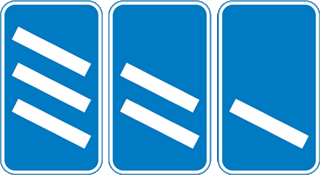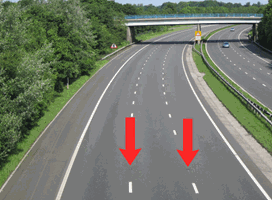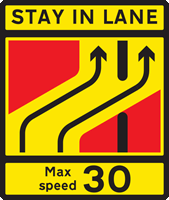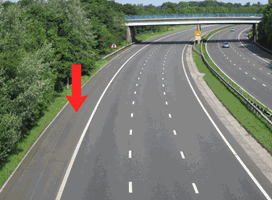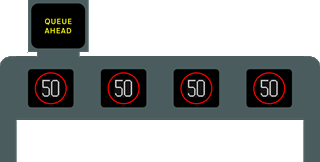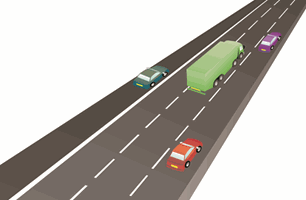There are 58 Motorway Rules Theory Test questions. You must get 86% (50 out of 58) to pass the test. You may review answers after each question by clicking the 'check answer' button or you can wait until the end of the test for your final score. Good luck!
Test Quick View
Click on an answer to view the correct choice along with the explanation.
Correct Answer: A
Explanation: You should give way to traffic already on the motorway. Where possible, traffic may move over to let you in, but don't force your way into the traffic stream. Traffic could be travelling at high speed, so try to match your speed to filter in without affecting the traffic flow.
Explanation: You should give way to traffic already on the motorway. Where possible, traffic may move over to let you in, but don't force your way into the traffic stream. Traffic could be travelling at high speed, so try to match your speed to filter in without affecting the traffic flow.
Correct Answer: D
Explanation: Travelling at the national speed limit doesn't allow you to hog the right-hand lane. Always use the left-hand lane whenever possible. When leaving a motorway, get into the left-hand lane well before your exit. Reduce your speed on the slip road and look out for sharp bends or curves and traffic queuing at roundabouts.
Explanation: Travelling at the national speed limit doesn't allow you to hog the right-hand lane. Always use the left-hand lane whenever possible. When leaving a motorway, get into the left-hand lane well before your exit. Reduce your speed on the slip road and look out for sharp bends or curves and traffic queuing at roundabouts.
Correct Answer: A
Explanation: On a motorway, all traffic should use the left-hand lane unless overtaking. When overtaking a number of slower vehicles, move back to the left-hand lane when you're safely past. Check your mirrors frequently and don't stay in the middle or right-hand lane if the left-hand lane is free.
Explanation: On a motorway, all traffic should use the left-hand lane unless overtaking. When overtaking a number of slower vehicles, move back to the left-hand lane when you're safely past. Check your mirrors frequently and don't stay in the middle or right-hand lane if the left-hand lane is free.
4. Which of these isn't allowed to travel in the right-hand lane of a three-lane motorway?
Mark one answer
B
C
D
Correct Answer: D
Explanation: A vehicle with a trailer is restricted to 60 mph. For this reason, it isn't allowed in the right-hand lane, as it might hold up faster-moving traffic that wishes to overtake in that lane.
Explanation: A vehicle with a trailer is restricted to 60 mph. For this reason, it isn't allowed in the right-hand lane, as it might hold up faster-moving traffic that wishes to overtake in that lane.
B
C
D
Correct Answer: A
Explanation: On a motorway, it's best to use a roadside emergency telephone so that the emergency services are able to find you easily. The location of the nearest telephone is shown by an arrow on marker posts at the edge of the hard shoulder. If you use a mobile, the operator will need to know your exact location. Before you call, find out the number on the nearest marker post. This number will identify your exact location.
Explanation: On a motorway, it's best to use a roadside emergency telephone so that the emergency services are able to find you easily. The location of the nearest telephone is shown by an arrow on marker posts at the edge of the hard shoulder. If you use a mobile, the operator will need to know your exact location. Before you call, find out the number on the nearest marker post. This number will identify your exact location.
6. You've had a breakdown on the hard shoulder of a motorway. When the problem has been fixed, how should you rejoin the main carriageway?
Mark one answer
B
C
D
Correct Answer: A
Explanation: Signal your intention and build up sufficient speed on the hard shoulder so that you can filter into a safe gap in the traffic. Don't push your way in, causing other traffic to alter speed or direction.
Explanation: Signal your intention and build up sufficient speed on the hard shoulder so that you can filter into a safe gap in the traffic. Don't push your way in, causing other traffic to alter speed or direction.
7. You're travelling along a motorway. Where would you find a crawler or climbing lane?
Mark one answer
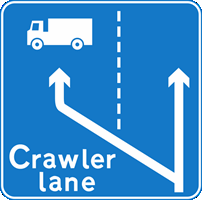
B
C
D
Correct Answer: D
Explanation: Large, slow-moving vehicles can hinder the progress of other traffic. On a steep gradient, an extra crawler lane may be provided for slow-moving vehicles to allow faster-moving traffic to flow more easily.
Explanation: Large, slow-moving vehicles can hinder the progress of other traffic. On a steep gradient, an extra crawler lane may be provided for slow-moving vehicles to allow faster-moving traffic to flow more easily.
Correct Answer: C
Explanation: The exit from a motorway is indicated by countdown markers. These are positioned 90 metres (100 yards) apart, the first being 270 metres (300 yards) from the start of the slip road. Move into the left-hand lane well before you reach the start of the slip road.
Explanation: The exit from a motorway is indicated by countdown markers. These are positioned 90 metres (100 yards) apart, the first being 270 metres (300 yards) from the start of the slip road. Move into the left-hand lane well before you reach the start of the slip road.
Correct Answer: C
Explanation: On motorways, reflective studs of various colours are fixed in the road between the lanes. These help you to identify which lane you're in when it's dark or in poor visibility. Amber-coloured studs are found on the right-hand edge of the main carriageway, next to the central reservation.
Explanation: On motorways, reflective studs of various colours are fixed in the road between the lanes. These help you to identify which lane you're in when it's dark or in poor visibility. Amber-coloured studs are found on the right-hand edge of the main carriageway, next to the central reservation.
Correct Answer: D
Explanation: White studs are found between the lanes on motorways. They reflect back the light from your headlights. This is especially useful in bad weather, when visibility is restricted.
Explanation: White studs are found between the lanes on motorways. They reflect back the light from your headlights. This is especially useful in bad weather, when visibility is restricted.
Correct Answer: B
Explanation: The studs between the carriageway and the hard shoulder are normally red. These change to green where there's a slip road, helping you to identify slip roads when visibility is poor or when it's dark.
Explanation: The studs between the carriageway and the hard shoulder are normally red. These change to green where there's a slip road, helping you to identify slip roads when visibility is poor or when it's dark.
12. You've broken down on a motorway. In which direction should you walk to find the nearest emergency telephone?
Mark one answer
B
C
D
Correct Answer: C
Explanation: Along the hard shoulder there are marker posts at 100-metre intervals. These will direct you to the nearest emergency telephone.
Explanation: Along the hard shoulder there are marker posts at 100-metre intervals. These will direct you to the nearest emergency telephone.
13. You're joining a motorway. Why is it important to make full use of the slip road?
Mark one answer
B
C
D
Correct Answer: D
Explanation: Try to join the motorway without affecting the progress of the traffic already travelling on it. Always give way to traffic already on the motorway. At busy times you may have to slow down to merge into slow-moving traffic.
Explanation: Try to join the motorway without affecting the progress of the traffic already travelling on it. Always give way to traffic already on the motorway. At busy times you may have to slow down to merge into slow-moving traffic.
Correct Answer: A
Explanation: Traffic is passing you at speed. If the draught from a large lorry catches you by surprise, it could blow you off balance and even onto the carriageway. By facing the oncoming traffic, you can see approaching lorries and so be prepared for their draught. You'll also be in a position to see other hazards approaching.
Explanation: Traffic is passing you at speed. If the draught from a large lorry catches you by surprise, it could blow you off balance and even onto the carriageway. By facing the oncoming traffic, you can see approaching lorries and so be prepared for their draught. You'll also be in a position to see other hazards approaching.
15. You're on a motorway. What colour are the reflective studs on the left of the carriageway?
Mark one answer
B
C
D
Correct Answer: C
Explanation: Red studs are placed between the edge of the carriageway and the hard shoulder. Where slip roads leave or join the motorway, the studs are green.
Explanation: Red studs are placed between the edge of the carriageway and the hard shoulder. Where slip roads leave or join the motorway, the studs are green.
Correct Answer: C
Explanation: On a three-lane motorway, you should travel in the left-hand lane unless you're overtaking. This applies regardless of the speed at which you're travelling.
Explanation: On a three-lane motorway, you should travel in the left-hand lane unless you're overtaking. This applies regardless of the speed at which you're travelling.
Correct Answer: B
Explanation: At roadworks, and especially where a contraflow system is operating, a speed restriction is likely to be in place. Keep to the lower speed limit and don't
- switch lanes
- get too close to the vehicle in front of you.
Be aware that there will be no permanent barrier between you and the oncoming traffic.
Explanation: At roadworks, and especially where a contraflow system is operating, a speed restriction is likely to be in place. Keep to the lower speed limit and don't
- switch lanes
- get too close to the vehicle in front of you.
Be aware that there will be no permanent barrier between you and the oncoming traffic.
18. You're on a three-lane motorway. There are red reflective studs on your left and white ones to your right. Which lane are you in?
Mark one answer
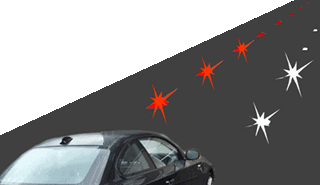
B
C
D
Correct Answer: A
Explanation: The colours of the reflective studs on the motorway and their locations are
- red - between the hard shoulder and the carriageway
- white - between lanes
- amber - between the carriageway and the central reservation
- green - along slip-road exits and entrances
- bright green/yellow - at roadworks and contraflow systems
Explanation: The colours of the reflective studs on the motorway and their locations are
- red - between the hard shoulder and the carriageway
- white - between lanes
- amber - between the carriageway and the central reservation
- green - along slip-road exits and entrances
- bright green/yellow - at roadworks and contraflow systems
Correct Answer: B
Explanation: Collisions often happen at roadworks. Be aware of the speed limits, slow down in good time and keep your distance from the vehicle in front.
Explanation: Collisions often happen at roadworks. Be aware of the speed limits, slow down in good time and keep your distance from the vehicle in front.
Correct Answer: D
Explanation: Motorways mustn't be used by pedestrians, cyclists, motorcycles under 50 cc, certain slow-moving vehicles without permission, and invalid carriages weighing less than 254 kg (560 lbs).
Explanation: Motorways mustn't be used by pedestrians, cyclists, motorcycles under 50 cc, certain slow-moving vehicles without permission, and invalid carriages weighing less than 254 kg (560 lbs).
Correct Answer: B
Explanation: Traffic on motorways usually travels faster than on other roads. You need to be looking further ahead to give yourself more time to react to any hazard that may develop.
Explanation: Traffic on motorways usually travels faster than on other roads. You need to be looking further ahead to give yourself more time to react to any hazard that may develop.
Correct Answer: A
Explanation: Stay in the left-hand lane long enough to get used to the higher speeds of motorway traffic before considering overtaking.
Explanation: Stay in the left-hand lane long enough to get used to the higher speeds of motorway traffic before considering overtaking.
Correct Answer: C
Explanation: You should keep to the left and only use the right-hand lane if you're passing slower-moving traffic.
Explanation: You should keep to the left and only use the right-hand lane if you're passing slower-moving traffic.
Correct Answer: C
Explanation: Don't use the hard shoulder for stopping unless it's an emergency. If you want to stop for any other reason, go to the next exit or service station.
Explanation: Don't use the hard shoulder for stopping unless it's an emergency. If you want to stop for any other reason, go to the next exit or service station.
25. You're in the right-hand lane of a three-lane motorway. What do these overhead signs mean?
Mark one answer

B
C
D
Correct Answer: B
Explanation: You must obey these signs even if there appear to be no problems ahead. There could be queuing traffic or another hazard which you can't yet see.
Explanation: You must obey these signs even if there appear to be no problems ahead. There could be queuing traffic or another hazard which you can't yet see.
Correct Answer: D
Explanation: You must stop if overhead gantry signs show flashing red lights above every lane on the motorway. If any of the other lanes doesn't show flashing red lights or a red cross, you may move into that lane and continue if it's safe to do so.
Explanation: You must stop if overhead gantry signs show flashing red lights above every lane on the motorway. If any of the other lanes doesn't show flashing red lights or a red cross, you may move into that lane and continue if it's safe to do so.
27. You're travelling in the left-hand lane of a three-lane motorway. How should you react to traffic joining from a slip road?
Mark one answer
B
C
D
Correct Answer: B
Explanation: Plan well ahead when approaching a slip road. If you see traffic joining the motorway, move to another lane if it's safe to do so. This can help the flow of traffic joining the motorway, especially at peak times.
Explanation: Plan well ahead when approaching a slip road. If you see traffic joining the motorway, move to another lane if it's safe to do so. This can help the flow of traffic joining the motorway, especially at peak times.
Correct Answer: A
Explanation: You should normally travel in the left-hand lane unless you're overtaking a slower-moving vehicle. When you've finished overtaking, move back into the left-hand lane, but don't cut across in front of the vehicle that you've overtaken.
Explanation: You should normally travel in the left-hand lane unless you're overtaking a slower-moving vehicle. When you've finished overtaking, move back into the left-hand lane, but don't cut across in front of the vehicle that you've overtaken.
29. You're travelling along a motorway. When are you allowed to overtake on the left?
Mark one answer
B
C
D
Correct Answer: A
Explanation: Never overtake on the left, unless the traffic is moving in queues and the queue on your right is moving more slowly than the one you're in.
Explanation: Never overtake on the left, unless the traffic is moving in queues and the queue on your right is moving more slowly than the one you're in.
Correct Answer: D
Explanation: Emergency refuge areas are built at the side of the hard shoulder. If you break down, try to get your vehicle into the refuge, where there's an emergency telephone. The phone connects directly to a control centre. Remember to take care when rejoining the motorway, especially if the hard shoulder is being used as a running lane.
Explanation: Emergency refuge areas are built at the side of the hard shoulder. If you break down, try to get your vehicle into the refuge, where there's an emergency telephone. The phone connects directly to a control centre. Remember to take care when rejoining the motorway, especially if the hard shoulder is being used as a running lane.
31. Traffic officers operate on motorways and some primary routes in England. What are they authorised to do?
Mark one answer
B
C
D
Correct Answer: D
Explanation: Traffic officers don't have enforcement powers but are able to stop and direct people on motorways and some 'A' class roads. They only operate in England and work in partnership with the police at incidents, providing a highly trained and visible service. They're recognised by an orange-and-yellow jacket and their vehicle has yellow-and-black markings.
Explanation: Traffic officers don't have enforcement powers but are able to stop and direct people on motorways and some 'A' class roads. They only operate in England and work in partnership with the police at incidents, providing a highly trained and visible service. They're recognised by an orange-and-yellow jacket and their vehicle has yellow-and-black markings.
32. You're on a motorway. A red cross is displayed above the hard shoulder. What does this mean?
Mark one answer

B
C
D
Correct Answer: D
Explanation: Active traffic management operates on some motorways. Within these areas, at certain times, the hard shoulder will be used as a running lane. A red cross above the hard shoulder shows that this lane should only be used for emergencies and breakdowns.
Explanation: Active traffic management operates on some motorways. Within these areas, at certain times, the hard shoulder will be used as a running lane. A red cross above the hard shoulder shows that this lane should only be used for emergencies and breakdowns.
33. You're on a smart motorway. A mandatory speed limit is displayed above the hard shoulder. What does this mean?
Mark one answer
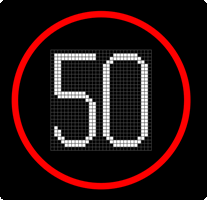
B
C
D
Correct Answer: A
Explanation: A mandatory speed-limit sign above the hard shoulder shows that this part of the road can be used as a running lane between junctions. You must stay within the speed limit. Look out for vehicles that may have broken down and could be blocking the hard shoulder.
Explanation: A mandatory speed-limit sign above the hard shoulder shows that this part of the road can be used as a running lane between junctions. You must stay within the speed limit. Look out for vehicles that may have broken down and could be blocking the hard shoulder.
Correct Answer: C
Explanation: Smart motorway schemes are intended to reduce congestion and make journey times more reliable. In these areas, the hard shoulder may be used as a running lane to ease congestion at peak times or in the event of an incident. Variable speed limits are used to help keep the traffic moving and to avoid bunching.
Explanation: Smart motorway schemes are intended to reduce congestion and make journey times more reliable. In these areas, the hard shoulder may be used as a running lane to ease congestion at peak times or in the event of an incident. Variable speed limits are used to help keep the traffic moving and to avoid bunching.
Correct Answer: D
Explanation: When a smart motorway is operating, you must follow the mandatory signs on the gantries above each lane, including the hard shoulder. Variable speed limits help keep the traffic moving and also help to prevent bunching.
Explanation: When a smart motorway is operating, you must follow the mandatory signs on the gantries above each lane, including the hard shoulder. Variable speed limits help keep the traffic moving and also help to prevent bunching.
36. Why can it be an advantage for traffic speed to stay constant over a longer distance?
Mark one answer
B
C
D
Correct Answer: D
Explanation: When traffic travels at a constant speed over a longer distance, journey times normally improve. You may feel that you could travel faster for short periods, but this generally leads to bunching and increased overall journey time.
Explanation: When traffic travels at a constant speed over a longer distance, journey times normally improve. You may feel that you could travel faster for short periods, but this generally leads to bunching and increased overall journey time.
37. You shouldn't normally travel on the hard shoulder of a motorway. When can you use it?
Mark one answer
B
C
D
Correct Answer: A
Explanation: Normally, you should only use the hard shoulder for emergencies and breakdowns, and at roadworks when signs direct you to do so. Smart motorways use active traffic management to ease congestion. In these areas, the hard shoulder may be used as a running lane when speed-limit signs are shown directly above.
Explanation: Normally, you should only use the hard shoulder for emergencies and breakdowns, and at roadworks when signs direct you to do so. Smart motorways use active traffic management to ease congestion. In these areas, the hard shoulder may be used as a running lane when speed-limit signs are shown directly above.
Correct Answer: D
Explanation: Congestion can be reduced by keeping traffic at a constant speed. At busy times, maximum speed limits are displayed on overhead gantries. These can be varied quickly, depending on the amount of traffic. By keeping to a constant speed on busy sections of motorway, overall journey times are normally improved.
Explanation: Congestion can be reduced by keeping traffic at a constant speed. At busy times, maximum speed limits are displayed on overhead gantries. These can be varied quickly, depending on the amount of traffic. By keeping to a constant speed on busy sections of motorway, overall journey times are normally improved.
Correct Answer: C
Explanation: You shouldn't normally stop on a motorway, but there may be occasions when you need to do so. If you're unfortunate enough to break down, make every effort to pull up on the hard shoulder.
Explanation: You shouldn't normally stop on a motorway, but there may be occasions when you need to do so. If you're unfortunate enough to break down, make every effort to pull up on the hard shoulder.
40. Unless signs show otherwise, what's the national speed limit for a car or motorcycle on a motorway?
Mark one answer
B
C
D
Correct Answer: C
Explanation: The national speed limit for a car or motorcycle on a motorway is 70 mph. Lower speed limits may be in force; for example, at roadworks. Variable speed limits also operate in some areas when the motorway is very busy. Cars or motorcycles towing trailers are subject to a lower speed limit.
Explanation: The national speed limit for a car or motorcycle on a motorway is 70 mph. Lower speed limits may be in force; for example, at roadworks. Variable speed limits also operate in some areas when the motorway is very busy. Cars or motorcycles towing trailers are subject to a lower speed limit.
41. You're on a motorway and there are red flashing lights above every lane. What must you do?
Mark one answer
B
C
D
Correct Answer: D
Explanation: Red flashing lights above all lanes mean you must stop and wait. You'll also see a red cross lit up. Don't change lanes, don't continue and don't pull onto the hard shoulder (unless in an emergency).
Explanation: Red flashing lights above all lanes mean you must stop and wait. You'll also see a red cross lit up. Don't change lanes, don't continue and don't pull onto the hard shoulder (unless in an emergency).
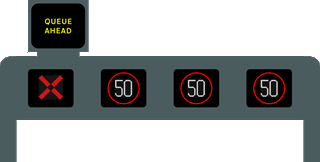
B
C
D
Correct Answer: D
Explanation: A red cross above the hard shoulder shows that it's closed as a running lane and should only be used for emergencies or breakdowns. On a smart motorway, the hard shoulder may be used as a running lane at busy times. This will be shown by a mandatory speed limit on the gantry above the hard shoulder.
Explanation: A red cross above the hard shoulder shows that it's closed as a running lane and should only be used for emergencies or breakdowns. On a smart motorway, the hard shoulder may be used as a running lane at busy times. This will be shown by a mandatory speed limit on the gantry above the hard shoulder.
Correct Answer: A
Explanation: You must obey mandatory speed-limit signs above motorway lanes, including the hard shoulder. In this case, you can use the hard shoulder as a running lane but you should look for any vehicles that may have broken down and may be blocking the hard shoulder.
Explanation: You must obey mandatory speed-limit signs above motorway lanes, including the hard shoulder. In this case, you can use the hard shoulder as a running lane but you should look for any vehicles that may have broken down and may be blocking the hard shoulder.
44. You're travelling along a motorway and feel tired. Where should you stop to rest?
Mark one answer
B
C
D
Correct Answer: A
Explanation: If you feel tired, stop at the nearest service area. If that's too far away, leave the motorway at the next exit and find a safe place to stop. You mustn't stop on the carriageway or hard shoulder of a motorway except in an emergency, when in a traffic queue, or when signalled to do so by a police officer, a traffic officer or traffic signals. Plan your journey so that you have regular rest stops.
Explanation: If you feel tired, stop at the nearest service area. If that's too far away, leave the motorway at the next exit and find a safe place to stop. You mustn't stop on the carriageway or hard shoulder of a motorway except in an emergency, when in a traffic queue, or when signalled to do so by a police officer, a traffic officer or traffic signals. Plan your journey so that you have regular rest stops.
45. You're towing a trailer on a motorway. What's the speed limit for a car towing a trailer on this road?
Mark one answer
B
C
D
Correct Answer: C
Explanation: Don't forget that you're towing a trailer. If you're towing a small, light trailer, it won't reduce your vehicle's performance by very much. However, strong winds or buffeting from large vehicles might cause the trailer to snake from side to side. Be aware of your speed and don't exceed the reduced speed limit imposed on vehicles towing trailers.
Explanation: Don't forget that you're towing a trailer. If you're towing a small, light trailer, it won't reduce your vehicle's performance by very much. However, strong winds or buffeting from large vehicles might cause the trailer to snake from side to side. Be aware of your speed and don't exceed the reduced speed limit imposed on vehicles towing trailers.
Correct Answer: B
Explanation: You should drive in the left-hand lane whenever possible. Only use the other lanes for overtaking or when directed to do so by signals. Using other lanes when the left-hand lane is empty can frustrate drivers behind you.
Explanation: You should drive in the left-hand lane whenever possible. Only use the other lanes for overtaking or when directed to do so by signals. Using other lanes when the left-hand lane is empty can frustrate drivers behind you.
47. You're driving on a motorway and have to slow down quickly due to a hazard ahead. How can you warn drivers behind of the hazard?
Mark one answer
B
C
D
Correct Answer: C
Explanation: Using your hazard warning lights, as well as your brake lights, will give following traffic an extra warning of the problem ahead. Only use them for long enough for your warning to be seen.
Explanation: Using your hazard warning lights, as well as your brake lights, will give following traffic an extra warning of the problem ahead. Only use them for long enough for your warning to be seen.
48. Your car gets a puncture while you're driving on the motorway. You get it onto the hard shoulder. What should you do?
Mark one answer
B
C
D
Correct Answer: D
Explanation: Park as far to the left as you can and leave the vehicle by the nearside door. Don't attempt even simple repairs. Instead, walk to an emergency telephone on your side of the road and phone for help. While waiting for help to arrive, stay by your car, keeping well away from the carriageway and hard shoulder.
Explanation: Park as far to the left as you can and leave the vehicle by the nearside door. Don't attempt even simple repairs. Instead, walk to an emergency telephone on your side of the road and phone for help. While waiting for help to arrive, stay by your car, keeping well away from the carriageway and hard shoulder.
49. You're driving on a motorway. By mistake, you go past the exit that you wanted to take. What should you do?
Mark one answer
B
C
D
Correct Answer: C
Explanation: It's illegal to reverse, cross the central reservation or drive against the traffic flow on a motorway. If you miss your exit, carry on until you reach the next one. Ask yourself why you missed your exit - if you think that your concentration is fading, take a break before completing your journey.
Explanation: It's illegal to reverse, cross the central reservation or drive against the traffic flow on a motorway. If you miss your exit, carry on until you reach the next one. Ask yourself why you missed your exit - if you think that your concentration is fading, take a break before completing your journey.
50. Your vehicle has broken down on a motorway. You aren't able to stop on the hard shoulder. What should you do?
Mark one answer
B
C
D
Correct Answer: D
Explanation: If you can't get your vehicle onto the hard shoulder, use your hazard warning lights to warn others. Leave your vehicle only when you can safely get clear of the carriageway. Don't try to repair the vehicle or attempt to place any warning device on the carriageway.
Explanation: If you can't get your vehicle onto the hard shoulder, use your hazard warning lights to warn others. Leave your vehicle only when you can safely get clear of the carriageway. Don't try to repair the vehicle or attempt to place any warning device on the carriageway.
51. Why is it particularly important to carry out a check on your vehicle before making a long motorway journey?
Mark one answer
B
C
D
Correct Answer: A
Explanation: Before you start your journey, make sure that your vehicle can cope with the demands of high-speed driving. You should check a number of things, the main ones being oil, water and tyres. You also need to plan rest stops if you're making a long journey.
Explanation: Before you start your journey, make sure that your vehicle can cope with the demands of high-speed driving. You should check a number of things, the main ones being oil, water and tyres. You also need to plan rest stops if you're making a long journey.
52. You're driving on a motorway. The car in front shows its hazard warning lights for a short time. What does this tell you?
Mark one answer
B
C
D
Correct Answer: D
Explanation: If the vehicle in front shows its hazard warning lights, there may be an incident, stopped traffic or queuing traffic ahead. By keeping a safe distance from the vehicle in front, you're able to look beyond it and see any hazards well ahead.
Explanation: If the vehicle in front shows its hazard warning lights, there may be an incident, stopped traffic or queuing traffic ahead. By keeping a safe distance from the vehicle in front, you're able to look beyond it and see any hazards well ahead.
53. You're driving on the motorway. Well before you reach your intended exit, where should you position your vehicle?
Mark one answer
B
C
D
Correct Answer: B
Explanation: You'll see the first advance direction sign one mile from a motorway exit. If you're travelling at 60 mph in the right-hand lane, you'll only have about 50 seconds before you reach the countdown markers. There'll be another sign at the half-mile point. Move to the left-hand lane in good time. Don't cut across traffic at the last moment and don't risk missing your exit.
Explanation: You'll see the first advance direction sign one mile from a motorway exit. If you're travelling at 60 mph in the right-hand lane, you'll only have about 50 seconds before you reach the countdown markers. There'll be another sign at the half-mile point. Move to the left-hand lane in good time. Don't cut across traffic at the last moment and don't risk missing your exit.
B
C
D
Correct Answer: C
Explanation: When driving a motor car, a learner driver who holds a provisional driving licence must
- display red L plates (or D plates in Wales) to the front and rear of the vehicle
- be insured to drive the vehicle
- be accompanied by someone who's at least 21 years old and who has held for at least three years (and still holds) a full licence for the category of vehicle being driven.
Explanation: When driving a motor car, a learner driver who holds a provisional driving licence must
- display red L plates (or D plates in Wales) to the front and rear of the vehicle
- be insured to drive the vehicle
- be accompanied by someone who's at least 21 years old and who has held for at least three years (and still holds) a full licence for the category of vehicle being driven.
55. Your vehicle breaks down on the hard shoulder of a motorway. You need to use your mobile phone to call for help. What should you do?
Mark one answer
B
C
D
Correct Answer: A
Explanation: You should use an emergency telephone when you break down on the motorway; only use your mobile if this isn't possible. The emergency services need to know your exact location so they can reach you as quickly as possible. Look for a number on the nearest marker post beside the hard shoulder. Give this number when you call the emergency services.
Explanation: You should use an emergency telephone when you break down on the motorway; only use your mobile if this isn't possible. The emergency services need to know your exact location so they can reach you as quickly as possible. Look for a number on the nearest marker post beside the hard shoulder. Give this number when you call the emergency services.
56. You're towing a trailer along a three-lane motorway. When may you use the right-hand lane?
Mark one answer
B
C
D
Correct Answer: B
Explanation: If you're towing a caravan or trailer, you mustn't use the right-hand lane of a motorway with three or more lanes except in certain specified circumstances, such as when lanes are closed.
Explanation: If you're towing a caravan or trailer, you mustn't use the right-hand lane of a motorway with three or more lanes except in certain specified circumstances, such as when lanes are closed.
57. You're on a motorway. There's a contraflow system ahead. What would you expect to find?
Mark one answer
B
C
D
Correct Answer: A
Explanation: When approaching a contraflow system, reduce speed in good time and obey all speed limits. You may be travelling in a narrower lane than normal, with no permanent barrier between you and the oncoming traffic. Be aware that the hard shoulder may be used for traffic and the road ahead could be obstructed by slow-moving or broken-down vehicles.
Explanation: When approaching a contraflow system, reduce speed in good time and obey all speed limits. You may be travelling in a narrower lane than normal, with no permanent barrier between you and the oncoming traffic. Be aware that the hard shoulder may be used for traffic and the road ahead could be obstructed by slow-moving or broken-down vehicles.
Correct Answer: C
Explanation: You should only stop on the hard shoulder in a genuine emergency. Don't stop there to have a rest or picnic, pick up hitchhikers, answer a mobile phone or check a map. If you miss your intended exit, carry on to the next. Never reverse along the hard shoulder.
Explanation: You should only stop on the hard shoulder in a genuine emergency. Don't stop there to have a rest or picnic, pick up hitchhikers, answer a mobile phone or check a map. If you miss your intended exit, carry on to the next. Never reverse along the hard shoulder.




